Japan's Official Development Assistance White Paper 2012
3. Addressing Global Issues
(1) Environment and Climate Change Issues
International discussions on environmental issues began in the 1970s. Through discussions at the United Nations Conference on Environment and Development (UNCED, also called the Earth Summit) in 1992, at the World Summit on Sustainable Development (WSSD) of 2002 and at the United Nations Conference on Sustainable Development (Rio+20) in June 2012, their importance has been increasingly recognized. Additionally, environment and climate change issues are repeatedly taken as one of main agendas at G8 and G20 Summits, and candid and constructive discussion among G8 leaders are held. The entire international community must address the environmental issues to ensure the prosperity of humankind in the future.
<Japan's Efforts>
●Environmental Pollution Control
With Japanese knowledge, experience and technology on environmental pollution control Japan is working for the resolution of pollution issues in developing countries. In particular, Japan supports measures against pollution and the improvement of the living environment in urban areas (measures against air pollution, prevention of water contamination, waste management, etc.), mainly in Asian countries that are achieving rapid economic growth.
●Caribbean Region
Sustainable Solid Waste Management in Caribbean Islands
Training Course in Japan (Multiple times, 2009 - 2011)
In the Caribbean island countries, recent economic development and population growth have led to an increase in waste. It is considering that most of disposal sites will reach to full capacity within 10 years. Though solid waste management has been paid a lot of attention as a priority issue for the Caribbean countries, any concrete measures have not yet been started.
Given this circumstances, Japan held training courses in themes of Japanese (particularly Okinawan) solid waste management techniques, knowledge and experience for 26 individuals from eight Caribbean countries from FY2009 to FY2011 in Okinawa. Okinawa's climate is similar to that of the Caribbean countries. Okinawa has been dealing with the costly problem of recyclables collection and transportation for a long time, due to nature of islands with limited land areas and distribution network. Okinawan unique effort, for example, increases the value of recycled products by dividing bottles by color to reduce mixture from foreign substances and keep consistent quality. Such Okinawan initiatives, as well as environmental education in close public-private coordination, have been taken back to respective countries by participants as applicable examples.
Specifically, participants have utilized the sustainable solid waste management plan developed during the training and started independent activities in respective countries, working with relevant authorities and NGOs. These activities include promoting separate collection by using separate plastic containers at schools and using compost from kitchen garbage to greenery activities in parks, which contributes to waste reduction as well.
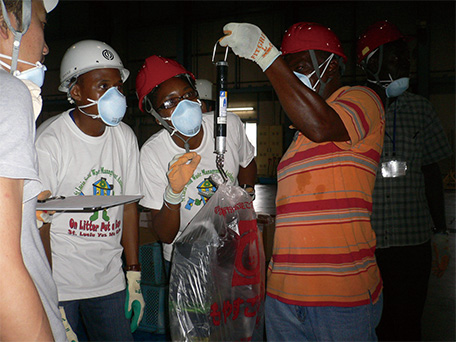
Waste quality is analyzed during solid waste management training. (Photo: JICA)
●Climate Change
Climate change threatens human security transcending national borders. As it is an urgent issue for humankind, the international community including both developed and developing countries should work together to strengthen measures to address climate change.
At the Seventeenth Conference of the Parties (COP17) to the United Nations Framework Convention on Climate Change (UNFCCC) held in Durban, South Africa at the end of 2011, Japan contributed to discussions positively and made constructive proposals for a new framework which is applicable to all parties. The four main results of these efforts were: (i) a pathway to a future framework; (ii) an agreement towards the establishment of the second commitment period of the Kyoto Protocol*; (iii) the operationalization of a Green Climate Fund (GCF)*; and (iv) a series of decisions regarding implementation of the Cancun Agreements*. Parties agreed on a basic design of the GCF and made progress on its establishment. At COP17, Japan announced its Vision and Actions toward Low-Carbon Growth and a Climate-Resilient World, so as to work on measures against global warming efficiency through international cooperation. This vision is comprised of three points: (i) cooperation among developed countries: efforts on technological innovation towards further greenhouse gas emissions reductions; (ii) cooperation with developing countries: dissemination and promotion of low carbon technologies* and the establishment of a new market mechanism; and (iii) support for developing countries: special consideration for vulnerable countries.
Based on this vision, Japan proposed the East Asia Low Carbon Growth Partnership to the participating countries of the East Asia Summit (EAS)(Note 9) as an effort to create and spread a low-carbon growth model in the East Asian region, which accounts for the world’s highest levels of greenhouse gas emissions. In April 2012, Japan held the East Asia Low Carbon Growth Partnership Dialogue in Tokyo. The participating countries agreed to cooperate as a region on the formulation and implementation of low-carbon growth strategies for each country, utilization of market and technologies, and the creation of the East Asia Knowledge Platform for Low Carbon Growth, which would serve as a network for various stakeholders. Japan has also been cooperating to formulate low-carbon growth strategies for the African region based on the framework of TICAD. In July 2012, Japan held the Policy Dialogue on Climate Change with island nations to exchange opinions on a wide variety of topics related to climate change and low-carbon growth.
In December 2009, Japan committed to provide approximately $15 billion in its support on climate change for developing countries by 2012, targeting both developing countries working on such measures and those vulnerable to the effects of climate change. Approximately $17.6 billion worth of assistance had been implemented as of the end of December 2012. Furthermore, Japan proposed and promoted its Bilateral Offset Credit Mechanism/Joint Crediting Mechanism* as a means of contributing to low-carbon growth in developing countries. Complementing the Clean Development Mechanism*, this Mechanism allows a partner country to help reduce its greenhouse gas (GHG) emissions by providing low-carbon technologies and allows the donor country to use its contribution to GHG emission reductions towards achieving its emission reduction targets. In order to start its operation as early as possible, Japan has made progress on consultations and feasibility studies in Indonesia and other Asian countries. On January 8, 2013, Japan signed the document to start this Mechanism with Mongolia for the first time ever. While promoting the implementation and necessary support for this project, Japan intends to continue to work with other countries on consultations and feasibility studies.
- *Kyoto Protocol
- A legal document adopted at the 1997 COP3 in Kyoto that determines responsibility for the reduction of GHG emissions. It mandates that the developed countries specified in the UNFCCC and countries that are undergoing the process of transition to a market economy achieve a fixed reduction of GHG emissions compared to 1990 levels over the 5-year period of 2008 - 2012. Japan bore a reduction responsibility of 6% (first commitment period). Japan decided not to participate in the protocol's second commitment period starting in 2013 at the COP17 held in 2011.
- *Cancun Agreements
- Comprehensive and balanced agreements adopted at COP16 that could become the basis for an international framework for climate change measures from 2013 on. In addition to its call to hold the increase in the average global temperature below 2 degrees above pre-industrial levels, it includes agreements on establishing the GCF and on examining the guidelines for measuring, reporting and verifying the implementation status of climate change measures in each country, taking note of reduction goals and activities submitted by member countries as compiled in UN documents based on the result of the previous year's COP15.
- *Green Climate Fund (GCF)
- A new fund that assists the efforts of developing countries to reduce GHG emissions and adapt to the impacts of climate change. Its establishment was agreed upon at the COP16 Cancun Agreements.
- *Bilateral Offset Credit Mechanism/Joint Crediting Mechanism
- Through the provision of technologies, products, systems, services, infrastructure, etc. related to the reduction of greenhouse gas emissions, this mechanism allows Japan's contributions to emissions reduction and absorption of GHG in developing countries to be evaluated quantitatively, while also allowing Japan to make use of its contributions towards achieving its emission reduction targets.
- *Clean Development Mechanism
- Introduced by the Kyoto Protocol as a means for each country to reach its GHG emission reduction targets. It is a system that allows countries to make use of GHG emission reductions of developing countries to achieve their own emission reduction targets.
- *Low-carbon technologies
- Environmentally-friendly technologies with low carbon (carbon dioxide) emissions. As technologically superior in this field, Japan has worked to use these technologies to reduce GHG emissions through assistance in high-efficient power plants, sustainable forest management, promoting and developing systems for energy-conservation and renewable energy, and solid waste management.
Note 9: East Asia Summit (EAS): Participating countries include Japan, China, Republic of Korea, Australia, New Zealand, India, the United States, Russia, and the 10 ASEAN countries
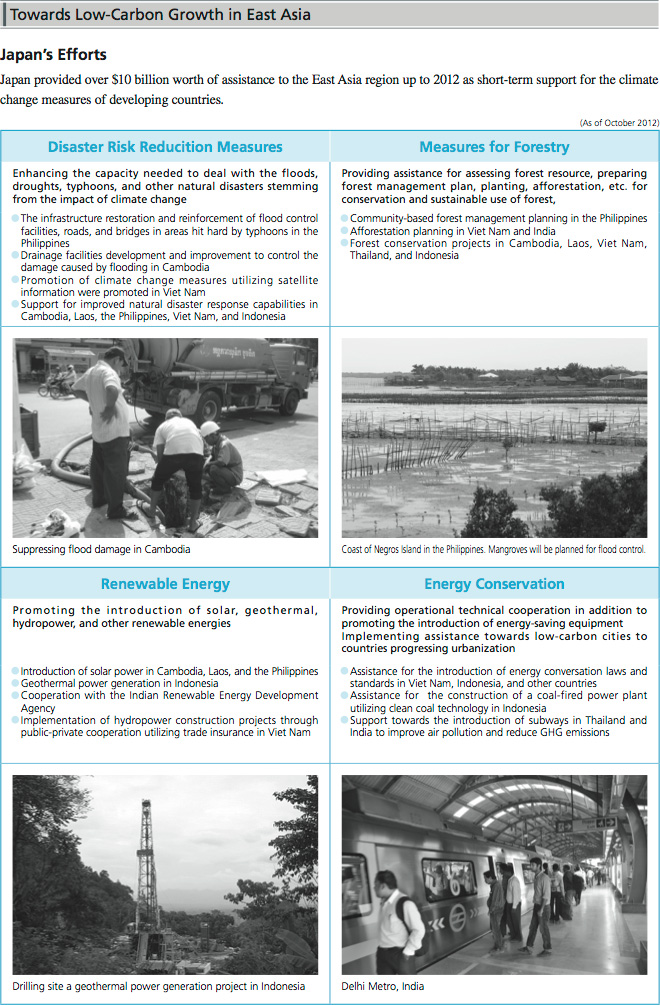
●Biodiversity
The Tenth Meeting of the Conference of the Parties to the Convention on Biological Diversity (CBD-COP10) and the Fifth Meeting of the Conference of the Parties Serving as the Meeting of the Parties to the Cartagena Protocol* on Biosafety (COP-MOP5) were held in Nagoya, Aichi Prefecture in October 2010. At the meeting, the Strategic Plan for Biodiversity 2011-2020 and the Aichi Biodiversity Targets*, which is a global target beginning in 2011 to effectively implement the Convention on Biological Diversity, the Nagoya Protocol*, which specifies concrete measures for Access and Benefit-Sharing (ABS) of genetic resources that should be implemented by each of the party countries, and the Nagoya-Kuala Lumpur Supplementary Protocol*, which stipulates the scope of responsibility and response measures when living modified organisms damage the ecosystem, were adopted. In addition, Japan announced the Initiative to Assist Developing Countries with the Conservation of Biodiversity (Life in Harmony Initiative) to support efforts by developing countries to achieve the Aichi Biodiversity Targets, pledging a total of $2 billion over a period of three years beginning in 2010, enhancing biodiversity conservation. Moreover Japan extended its initiative for the establishment of the Nagoya Protocol Implementation Fund (NPIF) at Global Environment Facility (GEF) and in 2011 contributed ¥1 billion to the fund in order to support early entry into force and effective implementation of the Nagoya Protocol.
It is extremely important to conserve biodiversity and ensure its sustainable use by working steadily toward achievement of these targets in the future.
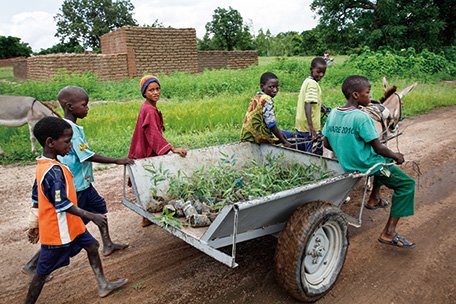
Boys carry seedlings back to a village for afforestation. (Photo: Akio Iizuka/JICA)

Living organisms are never aware of national borders, and the entire world should tackle biodiversity issues, therefore the "Convention on Biological Diversity" was created.
Objectives: Parties to the Convention work to achieve (i) the conservation of biological diversity, (ii) sustainable use of its components, and (iii) the fair and equitable sharing of the benefits arising out of the utilization of genetic resources including economic and technical supports from developed countries to developing countries.
- *The Strategic Plan for Biodiversity 2011-2020 and the Aichi Biodiversity Targets
- They are also called the "Post 2010 Biodiversity Targets." The medium- to long-term goal is to achieve harmony between humans and nature by 2050, with a short-term target of implementing actions to stop the loss of biological diversity by 2020. The Targets consist of 20 individual goals, including the control and preservation of at least 17% of land areas and 10% of ocean areas.
- *Nagoya Protocol
- A protocol regarding ABS (access to genetic resources and the fair and equitable sharing of benefits arising from their utilization). This protocol requires users of genetic resources (e.g. plants, animals and microbes involved in medical and food product development) who are in developed countries and others distribute the benefits borne of their use fairly among their providers.
- *Cartagena Protocol
- The Cartagena Protocol entered into force in 2003. It stipulates measures to ensure an adequate level of protection in the field of the safe transfer, handling, and the use of living modified organisms, to prevent living modified organisms which moved across borders from being released into the nature and adversely affect on the conservation and sustainable use of biodiversity.
- *Nagoya-Kuala Lumpur Supplementary Protocol
- The Nagoya-Kuala Lumpur Supplementary Protocol specifies "liability and redress" (who is responsible) and stipulates the implementation of response measures such as measures to prevent loss and measures for restoration that must be implemented by the responsible parties, when the maintenance of biodiversity, etc., has been adversely affected by the import and export of genetically modified organisms.
●Gabon
Conservation of Biodiversity in Tropical Forest through Sustainable Coexistence between Human and Wild Animals
Science and Technology Research Partnership for Sustainable Development (SATREPS) (September 2009 - Present)
The Congo Basin in central Africa is rich in biodiversity and contains a tropical forest second in size only to that of the Amazon. However, deforestation and other factors have caused concerns about the decline of tropical forests, and there is a strong call for preserving the forests and ecosystems of the basin.
Among the nations of the Congo Basin, Gabon has a particularly high percentage of forested land, much biodiversity and a large number of indigenous species. In order to protect the rich ecosystems within its borders, the Gabonese government designated 13 national parks that comprise over 10% of the country's total land area and has been encouraging eco-tourism and making other efforts. However, the scientific data about tropical forest ecosystems required for preservation work has not been collected and analyzed efficiently.
Kyoto University is the research entity representing the Japanese side for this project, and it has conducted collaborative research with Research Institute of Tropical Ecology (IRET) of Gabon for many years. The two are working together in Moukalaba-Doudou National Park in southern Gabon in which elephants, buffaloes, gorillas, chimpanzees and other large mammals live. This project is studying types and populations of flora and fauna living in the park, providing support based on scientific data aimed at preserving biodiversity, preventing zoonoses borne of contact between animals and humans and promoting sustainable eco-tourism using sustainable methods; and thereby contributing to the efforts of the Gabonese government to preserve biodiversity.
(As of December 2012)
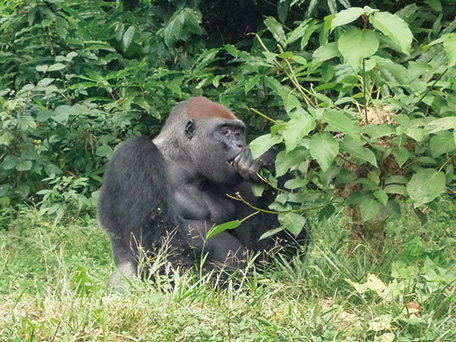
A gorilla around the researcher campsite (Photo: JICA)
●Tunisia
Valorization of Bio-resources in Semi Arid and Arid Land for Regional Development
SATREPS (May 2010 - Present)
The olives, grapes and medicinal plants that grow in the arid and semi-arid areas of Tunisia possess properties that allow them to survive extreme dryness and other harsh environmental conditions. People knew from local food culture and folklore that these plants contain unique elements with medicinal properties, but scientific research on those properties was not being conducted due to a lack of equipment in the area. Research and development to analyze and effectively utilize the properties of these plants is being conducted under this project, and data that scientifically supports the research and development is steadily becoming clear.
The Tsukuba University Alliance for Research on North Africa (ARENA) is the main Japanese entity working with Tunisian research institutions. ARENA works to analyze properties and investigate medicine and food product development possibilities while continuing to conduct research on conserving plant genetic resources within Tunisia. Identifying the properties and elements of these plants could eventually be linked to the development of medicine, medicinal cosmetics and functional food products effective against cancer and arteriosclerosis, as well as for preventing Alzheimer's disease and obesity, controlling allergies and whitening skin. Furthermore, the results of this research could boost the revenues of producers and manufacturers if medicine and health food products rich in these properties can be used in manufacturing and development.
(As of December 2012)
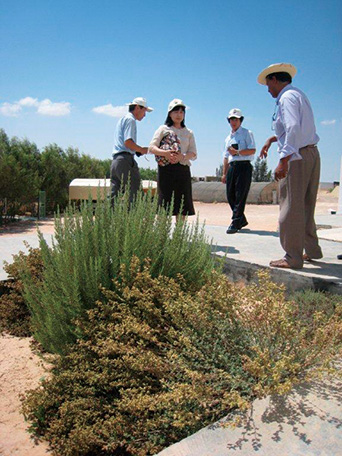
Survey of medicinal bio-resources at the Arid Regions Institute (IRA). (Photo: JICA)
